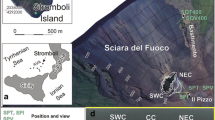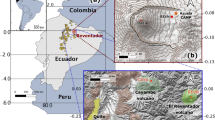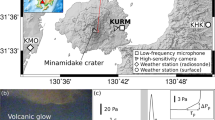Abstract
Gas pistoning is a type of eruptive behavior described first at Kīlauea volcano and characterized by the (commonly) cyclic rise and fall of the lava surface within a volcanic vent or lava lake. Though recognized for decades, its cause continues to be debated, and determining why and when it occurs has important implications for understanding vesiculation and outgassing processes at basaltic volcanoes. Here, we describe gas piston activity that occurred at the Pu‘u ‘Ō‘ō cone, in Kīlauea’s east rift zone, during June 2006. Direct, detailed measurements of lava level, made from time-lapse camera images captured at close range, show that the gas pistons during the study period lasted from 2 to 60 min, had volumes ranging from 14 to 104 m3, displayed a slowing rise rate of the lava surface, and had an average gas release duration of 49 s. Our data are inconsistent with gas pistoning models that invoke gas slug rise or a dynamic pressure balance but are compatible with models which appeal to gas accumulation and loss near the top of the lava column, possibly through the generation and collapse of a foam layer.





Similar content being viewed by others
References
Aster R, Mah S, Kyle P, McIntosh W, Dunbar N, Johnson J, Ruiz M, McNamara S (2003) Very long period oscillations of Mount Erebus Volcano. J Geophys Res 108(B11):2522. doi:10.1029/2002JB002101
Barker SR, Sherrod DR, Lisowski M, Heliker C, Nakata JS (2003) Correlation between lava-pond drainback, seismicity and ground deformation at Pu‘u ‘Ō‘ō. In: Heliker C, Swanson DA, Takahashi TJ (eds) The Pu‘u ‘Ō‘ō–Kupaianaha eruption of Kīlauea Volcano, Hawai‘i: the first 20 years. US Geol Surv Prof Pap 1676: 53–62
Cashman KV, Mangan MT, Newman S (1994) Surface degassing and modifications to vesicle size distributions in active basalt flows. J Volcanol Geotherm Res 61(1–2):45–68
Dibble RR (1972) Seismic and related phenomena at active volcanoes in New Zealand, Hawaii, and Italy. PhD dissertation, Victoria University, Wellington
Dibble RR, Kyle PR, Rowe CA (2008) Video and seismic observations of Strombolian eruptions at Erebus volcano, Antarctica. J Volcanol Geotherm Res 177:619–634
Edmonds M, Gerlach TM (2007) Vapor segregation and loss in basaltic melts. Geology 35:751–754
Elias T, Sutton AJ (2007) Sulfur dioxide emission rates from Kilauea Volcano, Hawai‘i, an update: 2002–2006. US Geol Surv Open-File Rep 2007-1114. http://pubs.usgs.gov/of/2007/1114/. Accessed 28 Aug 2012
Ferrazzini V, Aki K, Chouet B (1991) Characteristics of seismic waves composing Hawaiian volcanic tremor and gas-piston events observed by a near source array. J Geophys Res 96:6199–6209
Gerlach TM (1986) Exsolution of H2O, CO2, and S during eruptive episodes at Kilauea Volcano, Hawaii. J Geophys Res 91(B12):12,177–112,185
Gerlach TM, Graeber EJ (1985) Volatile budget of Kilauea Volcano. Nature 313(6000):273–277
Gerst A, Hort M, Kyle PR, Vöge M (2008) 4D velocity of Strombolian eruptions and man-made explosions derived from multiple Doppler radar instruments. J Volcanol Geotherm Res 177:648–660
Heliker C, Mattox TN (2003) The first two decades of the Pu‘u ‘Ō‘ō–Kupaianaha eruption: chronology and selected bibliography. In: Heliker C, Swanson DA, Takahashi TJ (eds) The Pu‘u ‘Ō‘ō–Kupaianaha eruption of Kīlauea Volcano, Hawai‘i: the first 20 years. US Geol Surv Prof Pap 1676: 1–27
Heliker CC, Mangan MT, Mattox TN, Kauahikaua JP, Helz RT (1998) The character of long-term eruptions: inferences from episodes 50–53 of the Pu‘u ‘Ō‘ō–Kūpaianaha eruption of Kīlauea Volcano. Bull Volcanol 59(6):381–393
Heliker C, Kauahikaua J, Sherrod DR, Lisowski M, Cervelli P (2003) The rise and fall of Pu‘u ‘Ō‘ō cone, 1983–2002. In: Heliker C, Swanson DA, Takahashi TJ (eds) The Pu‘u ‘Ō‘ō–Kupaianaha eruption of Kīlauea Volcano, Hawai‘i: the first 20 years. US Geol Surv Prof Pap 1676: 29–51
Hon K, Kauahikaua J, Denlinger R, Mackay K (1994) Emplacement and inflation of pahoehoe sheet flows: observations and measurements of active lava flows on Kilauea Volcano, Hawaii. Geol Soc Am Bull 106(3):351–370
James MR, Lane SJ, Corder SB (2008) Modelling the rapid near-surface expansion of gas slugs in low-viscosity magmas. In: Lane SJ, Gilbert JS (eds) Fluid motions in volcanic conduits: a source of seismic and acoustic signals. Geol Soc London Spec Publ 307: 147–167
Jaupart C, Vergniolle S (1988) Laboratory models of Hawaiian and Strombolian eruptions. Nature 331:58–60
Johnson JB, Harris AJL, Hoblitt RP (2005) Thermal observations of gas pistoning at Kilauea volcano. J Geophys Res 110:B11201. doi:10.1029/2005JB003944
Kauahikaua J, Mangan M, Heliker C, Mattox T (1996) A quantitative look at the demise of a basaltic vent: the death of Kupaianaha, Kilauea Volcano, Hawai‘i. Bull Volcanol 57(8):641–648
Marchetti E, Harris AJL (2008) Trends in activity at Pu‘u ‘O‘o during 2001–2003: insights from the continuous thermal record. In: Lane SJ, Gilbert JS (eds) Fluid motions in volcanic conduits: a source of seismic and acoustic signals. Geol Soc London Spec Pub 307: 85–101
Mattox TN, Heliker C, Kauahikaua J, Hon K (1993) Development of the 1990 Kalapana flow field, Kilauea Volcano, Hawaii. Bull Volcanol 55(6):407–413
Orr T, Hoblitt RP (2008) A versatile time-lapse camera system developed by the Hawaiian Volcano Observatory for use at Kīlauea Volcano, Hawai‘i. US Geol Surv Sci Invest Rept 2008-5117. http://pubs.usgs.gov/sir/2008/5117. Accessed 28 Aug 2012
Orr TR, Patrick MR, Wilson D, Sutton AJ, Elias T (2010) The impact of rockfalls on shallow degassing processes during the 2008–2010 summit eruption of Kīlauea Volcano, Hawai‘i: Abstract #V21C-2340 presented at 2010 Fall Meeting, AGU, San Francisco, California, 13–17 Dec
Patrick MR, Harris AJL, Ripepe M, Dehn J, Rothery DA, Calvari S (2007) Strombolian explosive styles and source conditions: insights from thermal (FLIR) video. Bull Volcanol 69:769–784
Patrick MR, Kauahikaua JP, Antolik L (2010) MATLAB tools for improved characterization and quantification of volcanic incandescence in Webcam imagery: applications at Kīlauea Volcano, Hawai‘i. US Geol Tech Method 13-A1. http://pubs.usgs.gov/tm/tm13a1/. Accessed 28 Aug 2012
Patrick M, Wilson D, Fee D, Orr T, Swanson D (2011a) Shallow degassing events as a trigger for very-long-period seismicity at Kīlauea Volcano, Hawai‘i. Bull Volcanol 73(9):1179–1186
Patrick MR, Orr T, Wilson D, Dow D, Freeman R (2011b) Cyclic spattering, seismic tremor, and surface fluctuation within a perched lava channel, Kīlauea Volcano. Bull Volcanol 73(6):639–653
Ripepe M, Marchetti E (2002) Array tracking of infrasonic sources at Stromboli volcano. Geophys Res Lett 29:2076. doi:10.1029/2002GL015452
Swanson DA, Jackson DB, Duffield WA, Peterson DW (1971) Mauna Ulu eruption, Kilauea Volcano. Geotimes 16(5):12–16
Swanson DA, Duffield WA, Jackson DB, Peterson DW (1979) Chronological narrative of the 1969–71 Mauna Ulu eruption of Kilauea volcano, Hawaii. US Geol Surv Prof Pap 1056
Tilling RI, Christiansen RL, Duffield WA, Endo ET, Holcomb RT, Koyanagi RY, Peterson DW, Unger JD (1987) The 1972–1974 Mauna Ulu eruption, Kilauea Volcano: an example of quasi-steady-state magma transfer. In: Decker RW, Wright TL, Stauffer PH (eds) Volcanism in Hawaii. US Geol Surv Prof Pap 1350, 2: 405–469
Vergniolle S, Mangan M (2000) Hawaiian and Strombolian eruptions. In: Sigurdsson H, Houghton BF, McNutt S, Rymer H, Stix J (eds) Encyclopedia of volcanoes. Academic, San Diego, pp 447–461
Witham F, Woods AW, Gladstone C (2006) An analogue experimental model of depth fluctuations in lava lakes. Bull Volcanol 69(1):51–56
Wolfe EW, Neal CA, Banks NG, Duggan TJ (1988) Geologic observations and chronology of eruptive events. In: Wolfe EW (ed) The Puu Oo eruption of Kilauea Volcano, Hawaii: episodes 1–20, January 3, 1983, through June 8, 1984. US Geol Surv Prof Pap 1463, 1–97
Acknowledgments
We gratefully thank Hawaiian Volcano Observatory staff and volunteers for field support, observations, and discussions about gas piston processes. Paul Wessel at University of Hawai‘i at Mānoa provided the statistical analysis of gas release durations, for which we are appreciative. Careful and constructive reviews by Bruce Houghton, Dave Sherrod, Mike James, and Letizia Spampinato improved the manuscript greatly.
Author information
Authors and Affiliations
Corresponding author
Additional information
Editorial responsibility: S. Calvari
Electronic supplementary material
Below is the link to the electronic supplementary material.
Time-lapse movie (960 × 720 frame size; 10 fps; 1 min acquisition interval) showing gas pistons at Drainhole vent spanning period from 18:30 on June 2, 2006 to 02:00 on June 3, 2006. Movie includes sequence used to compile data for Fig. 5. (MOV 13608 kb)
Time-lapse movie (960 × 720 frame size; 10 fps; 1 min acquisition interval) showing gas pistons at Drainhole vent spanning period from 06:00 to 13:20 on June 3, 2006. Movie includes gas piston shown in Fig. 3. (MOV 12116 kb)
Appendix
Appendix
The position of the lava surface within the Drainhole vent is calculated by re-projecting the lava surface from the image plane to the vertical plain defined by the vent wall. To achieve this, we first calculate the time-lapse camera’s angular field of view, or angle of view (AOV), in the vertical direction using the equation:
where α represents the vertical AOV, d represents the size of the camera’s optical sensor in the vertical direction (5.32 mm for digital cameras with a 1/1.8″ optical sensor), and f represents the focal length (8.0 mm; obtained from image metadata). Solving for α, we find the camera’s vertical AOV to be 36.8°. The same value was achieved when calculating vertical AOV directly from photographs of a flat object (the side of a building) of known size and distance from the camera. We ignore the radial distortion of the camera lens because our object of interest—the rising and falling lava surface—is near the center of the image, where radial distortion is negligible.
The inclination of the camera and the horizontal distance from the camera to the targeted vent wall defines a right triangle (Fig. 6a; in gray). From this, we use the cosine function for a right triangle to calculate a length of 12 m for the FOV center line, or principal ray (Fig. 6a; dashed red line). We also know that the acute angle formed by the intersection of the projected image plane and the vertical plane is equivalent to the inclination of the camera (26°) because it is complementary to the angle between the camera’s principal ray and the vertical plane. To find the relative vertical position of the lava surface in any time-lapse image, we must imagine a line extending from the camera to the point of intersection between the lava surface and the vent wall. We refer to this line as the target ray (Fig. 6b; dashed blue line). When the slope of the target ray is steeper than that of the principal ray, the target ray passes through the projected image plane. We can then ratio the number of vertical pixels that comprise the segment of the projected image plane between the principal ray and the target ray (Fig. 6b; solid blue line) to the number of pixels that comprise half the vertical image frame (600 pixels). Cross-multiplying this with 18.5° (half of the AOV) gives us the angle between the principal ray and the target ray. The tangent function for a right triangle can then be used to calculate the length of the projected image plane between the principal ray and the target ray (Fig. 6b; solid blue line).
Illustrations showing geometric details of time-lapse camera deployment at Drainhole vent. a Horizontal distance from camera to target (opposite wall of inner vent opening) is 11 m. Black dashed lines bound camera’s field of view; red dashed line represents camera’s principal ray, calculated length 12 m; red solid line, normal to principal ray, represents plane of projected image. b Black dashed lines bound camera’s field of view; red dashed line represents camera’s principal ray; blue dashed line represents target ray. Principal ray bisects projected image plane into upper and lower halves of 600 pixels each. Projected lava surface height represented by solid blue line; actual lava surface level represented by solid green line
We now define a new triangle bounded by the projected image plane, the vertical vent wall, and the target ray (Fig. 6b). For this triangle, the angle between the projected image plane and the vent wall is 26°, and the angle between the projected image plane and the target ray is a supplementary angle and can be readily calculated. Since we now know two angles and the length of the included side, we use the law of sines to find the length of the side that represents the level of the lava surface in the vertical plane (Fig. 6b; solid green line). Using a variation of this procedure, we calculate the vertical distance between the principal ray of the camera and the vent rim (because the principal ray was below the vent rim). We then add this value to our calculated measurement of the lava level below the principal ray to get the total distance from the vent rim to the lava surface.
This procedure is used to determine the position of the lava surface within the vent only when the surface is below the principal ray. A variation on this procedure is used when the lava surface rises above the camera’s principal ray. Inaccuracy in the inclination of the camera and the distance between the camera and the targeted vent or pit wall will lead to small errors in the calculated height of the lava surface, as will small errors in the value calculated for the camera’s angle of view. However, since the viewing geometry does not change from image to image, and because it is the relative change in the position of the lava surface that is important, we make no effort to quantify these errors and they are ignored.
Rights and permissions
About this article
Cite this article
Orr, T.R., Rea, J.C. Time-lapse camera observations of gas piston activity at Pu‘u ‘Ō‘ō, Kīlauea volcano, Hawai‘i. Bull Volcanol 74, 2353–2362 (2012). https://doi.org/10.1007/s00445-012-0667-0
Received:
Accepted:
Published:
Issue Date:
DOI: https://doi.org/10.1007/s00445-012-0667-0





